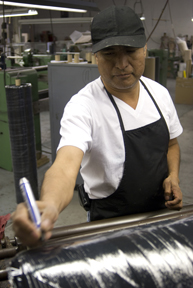IF YOU’RE LIKE MOST WOMEN, the morning ritual of hooking your bra and tucking away the twins is probably second nature. You don’t think twice about where the fabric comes from, who made those hooks and eyes or the Dolly-Parton padding.
But Lenny Staloff makes it his business to know. Affable and bespectacled with a degree in business administration, he’s president of Allied Bias Products, which supplies a crucial component to bra manufacturers.
On a typical Thursday afternoon, Allied feels relaxed. It’s a large, pleasingly messy, quietly humming space with concrete floors and a bunch of mystifying green metal machines. We’re in a factory—a real one, not one that’s been transformed into a condo with cathedral ceilings, sky lights, exposed brick, varnished wood, and Energy Star appliances, all of which could be yours for a cool million.
Before factories were industrial chic they were—factories.
SIX OR SEVEN YEARS ago, Allied Bias, which is located on a former-factory-filled stretch of Communipaw Avenue, would have been a hubbub of activity. Staloff describes his business at that time as flourishing. Now sales are down 80 percent and the workforce has shrunk to 10 from a high of 30.
Though manufacturing was the lifeblood of Jersey City from the 19th to the mid-20th centuries, now most of us would be hard pressed to name a single working factory or, even harder, describe what goes on there. What is everybody doing and what exactly are they making?
Feeling like the worst kind of gentrified Jersey Cityite, I put the question to Staloff. “Binding,” he says, reminding me of “plastics,” the most famous one-liner in film history. Turns out that binding is really just narrow strips of fabric. That’s it. That’s what they make. You can make them straight or on the bias. Two women in a smaller room operate specialized high-speed machines for sewing fancy trimmings. The big green machines in the main workroom are textile slitters, which cut rolls of fabric into various widths. Allied sells the stuff by the truckful to small domestic bra manufacturers in the Caribbean. In the old days they supplied to big manufacturers like Maidenform. Other suppliers pony up the shoulder straps, cups, hooks and eyes, and elastics, and when all the suppliers finish supplying—voila! You have a bra.
Allied used to put out more than two million yards of binding a week that was destined to be wrapped around underwires. Now, the output is closer to 400,000. The obvious question is, why not make the whole thing? “It’s very labor intensive,” says Steve Moskovitz, Allied’s plant manager. “There are 30 or 40 components of a bra that have to be sewn individually, while a pair of panties will have only two or three components. There is a lot of architecture in a bra, and we don’t have the manpower or expertise to do it.”
NEEDLESS TO SAY, ALLIED BIAS is feeling the pain. For the first time since his father bought the company in 1963, Staloff says the business is not recession proof, noting that the current economic crisis is just the “icing on the cake.” The real culprit is outsourcing. In a nutshell, the big box stores demanded low prices for their merchandise. Cheap goods meant cheap labor, which meant going offshore to find it.
Free-trade legislation like NAFTA and GATT benefited Central America, China, and Mexico, while putting U.S. suppliers in the red. The worst part of the economic crisis, Staloff says, is that banks, brokerage houses, car companies, and outfits like AIG—which were drowning in corruption and greed—got bailed out. “A carefully managed business like mine,” he says, got no such deals.
Allied is making a stab at diversifying by supplying binding to uniform manufacturers and the military, while low-wage factories in China are making a killing importing low-cost bras to the U.S.
Staloff is a mister nice guy whose staff was winnowed to 10, not by restructuring but by attrition. He wishes that he’d had the foresight to hire a sales staff that had been thinking earlier about survival tactics like diversification.
When we leave, Camilo gets a shot of the outside of the building. It’s a clear, warm winter day, the sky ice blue above the brickwork. An artsy craftsy relative latecomer to Jersey City, I find all factories beautiful.
Staloff doesn’t see it. “It’s a means to an end,” he says. “A factory is a factory.”JCM
